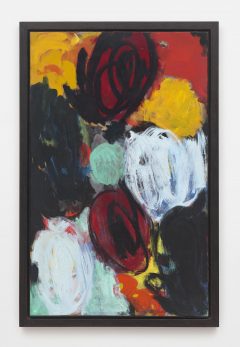Ernst Wilhelm Nay
Purpur und Hellblau
1961

Oil on canvas
160 × 100 cm / 63 × 39 3/8 in
Signed and dated »61«; also signed again, dated and titled on the stretcher on the verso
Catalogue Raisonné by Scheibler 1990 no. 986
The artist’s studio; The artist’s estate; Private Collection; Galerie Neher, Essen (1985); Private Collection Berlin (1990)
- Galerie Ludorff, Neuerwerbungen Frühjahr 2022, Düsseldorf 2022
- Martin-Gropius-Bau, "Der unverbrauchte Blick: Kunst unserer Zeit in Berliner Sicht", Berlin 29. Januar - 5. April 1987
- Galerie Neher, "Blickpunkte V", Essen 1985
- Galerie Ludorff, "Neuerwerbungen Frühjahr 2022", Düsseldorf 2022, S. 117
- Aurel Scheibler, "Ernst Wilhelm Nay – Werkverzeichnis der Ölgemälde" Bd. 2, 1952-1968, Köln 1990, Nr. 986
- Martin-Gropius-Bau, "Der unverbrauchte Blick: Kunst unserer Zeit in Berliner Sicht", Ausst.-Kat., Berlin 1987, m. Abb.
- Galerie Neher, "Blickpunkte V", Nr. 53, Ausst.-Kat., Essen 1985, S. 70
"A colorist is an artist who thinks through color and performs perception through color." (E.W. Nay)1
Ernst Wilhelm Nay is a painter of color. It is an element of design in his works and governs the picture. Nay uses color in such a way that it emphasizes the two-dimensionality of the canvas and does not create an illusion of depth. The artist himself speaks of "Gestaltfarbe", which is flat, even, planar, not illustrative or literary. That is the only way for it to become independent of its representational meaning and free for its original sensual effect.2 At the latest with his participation in the first three documenta exhibitions in Kassel3 and the biennials in São Paulo and Venice in 1956, Ernst Wilhelm Nay gained great reputation as a modernist artist. During his lifetime, he himself organized his work into groups and published the principles on which they were based. In 1955 his art-historical manifesto "Vom Gestaltwerk der Farbe" was published. Of his "Scheibenbildern", created from 1954 onwards, we see here the wonderful example "Purpur und Hellblau" ("Purple and Light Blue") from 1961. From the earliest years of his work, Nay used his own vocabulary of forms consisting of circles/discs, diamonds, jags, spindle/eye and hands. " Purpur und Hellblau" is primarily composed with discs of color, which Nay distributes across the picture surface in a precisely calculated dynamic. Nay speaks of "positive" and "negative colors": positive colors pushed forward, negative colors pushed backward, thus causing the picture to vibrate. Through this effect, Nay creates dynamics and an abstract pictorial space, which he calls "relief", which is determined and partly negated again by color, its movement and penetration. Nay himself explains the structure of his paintings accordingly: "The colors are to be combined into color circles, a number of yellow tones, lemon yellow, cadmium yellow, ocher, orange will be juxtaposed with a number of combined green or other tones. Passages will arise, the yellow will penetrate the green and vice versa, creating color tensions and dynamically activating the picture surface (...). Then there is the relief, which gives depth and pictorial space to the picture, not through the structure, but through the colorful order, and the possibility of adding the seemingly three-dimensional to the pictorial space, of fighting depth indication by height indication. "4 It is impressive how the painter repeatedly breaks the dynamics and spatial development in our painting. Nay balances the image-determining purple, which pushes forward as a positive color, with black spirals that lead the eye back again. He breaks up the black areas at the edges, which seem to push backwards, with lighter shades of blue that counteract this. He skillfully uses an alternation of impasto and glazing paint, reminiscent of watercolor, to heighten this effect. It is precisely the vehement and spirited crossing out of disc shapes, as by the spirals in our picture, that "clears the way for him [Nay] to create a new, powerful drama in his pictorial design, which then leads to another pictorial invention in 1963, with the emergence of the motif of the "eyes."5 "Purpur und Hellblau" thus emerges at an exciting transition from one series of the painter's paintings to the next - an important phase of his œuvre that makes the painter's development most impressively comprehensible.
1 Nay quoted after Franziska Müller, Ernst Wilhelm Nay's "Vom Gestaltwert der Farbe" als Künstlertheorie und Zeitzeugnis, o.O. 2016, p. 114.
2 Cf. Nay's remarks in his 1955 publication "Vom Gestaltwert der Farbe".
3 In the years 1955, 1959 and 1964.
4 E. W. Nay quoted after: E. W. Nay, "Bilder und Dokumente" ("Pictures and Documents"), exh. cat.., Munich 1980, p. 99.
5 Elisabeth Scheibler-Nay, "Scheibenbilder 1954-1962," in: Aurel Scheibler, "Ernst Wilhelm Nay - Werkverzeichnis der Ölgemälde," vol. 2, 1952-1968, Cologne 1990, p. 62.





